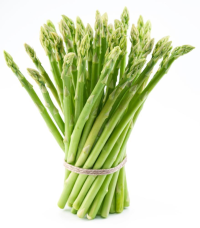Asparagus
 Overview
Overview
Asparagus (Asparagus officinalis) is a vegetable that is harvested at the beginning stages of the plant. When allowed to mature, the asparagus plant grows into an inedible fern. Edible asparagus is the young shoots or stalks of the plant. These stalks are harvested during a short season in the spring when the plant is about six to eight inches tall. Because the prime season for harvesting the vegetable is so limited, and because the harvest can be labor-intensive, asparagus tends to be more expensive than other vegetables. When prime for consumption, the stalks should be firm and the bud that tops each stalk should still be tightly closed. While some asparagus plants are grown in the absence of direct sunlight to create white asparagus, most asparagus is green in color; generally, the darker the color, the more nutritious the stalk. However, in order to reap the most health benefits from asparagus it should be eaten fairly quickly after purchase as the vegetable begins to lose both important nutrients and flavor about two days after purchase. Asparagus is included in the same botanical family, the lily family, as onions, leeks, and garlic, and while there are over 300 different varieties of asparagus, only about 20 are safe for consumption.
History of Asparagus
Asparagus was originally grown in the Mediterranean region of the world, as well as northern and southern Africa. Egypt is possibly the very first country to have grown and harvested the vegetable. Asparagus was originally used for its medicinal qualities along with its nutritional benefits. It is now grown all over the world, typically in subtropical and temperate climates. The world’s leading producers of the vegetable include the United States, Mexico, Peru, France, and Spain, as well as other Mediterranean countries.
Nutritional Information
Asparagus is rich in many nutrients. It is very high in potassium, and maintains a healthy balance between potassium and sodium. It is higher in protein than most other vegetables, and provides a good source of vitamins K, C, and A, as well as folic acid. Asparagus is low in both carbohydrates and calories in general: there are only about 24 calories in one cup of asparagus, and almost half of those calories are from protein. The vegetable is also high in fiber. Asparagus is a source of the Vitamin B complex, iron, calcium, iodine, and zinc. It contains an amino acid called asparagines, which works to flush waste from the body but may also cause odorous urine.
Health Benefits of Asparagus
Perhaps the most notable health benefit that asparagus has to offer is its anti-inflammatory affects. Asparagus contains antioxidants and other compounds that block certain enzymes responsible for inflammation, which is why asparagus may help alleviate inflammation. In turn, the vegetable is helpful in treating rheumatism and arthritis. Asparagus also contains antioxidants, specifically glutathione, which may help prevent the development of eye problems such as cataracts as well as cancer. Furthermore, the saponins in asparagus may help prevent the development of leukemia, while the inulin found in the vegetable encourages digestive health. Asparagus also has diuretic properties, which presumably result from the asparagines, the amino acid that is responsible for the odor the vegetable can induce in human urine.
References
- Holford, P. The optimum nutrition bible, Little Brown Group (2004)
- Holford, P & Lawson, S. Optimum Nutrition Made Easy How to achieve optimum health, Piatkus Books (2008)
- Murray, M.T. et al., Encyclopedia of healing foods, London : Piatkus (2005)
- The National Research Council. Recommended Dietary Allowances, 10th ed, National Academy of Sciences (1989)
- Werbach, M. Nutritional Influences on Illness, 2nd ed, Third Line Press (1993)
Posted in Asparagus
Ask a Question Or Join a Discussion


